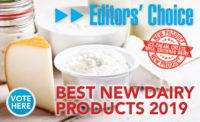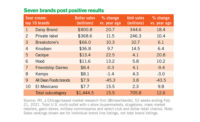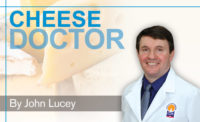It's Prime Time for Probiotics - Don't Blow It!
I’ve been a fan of probiotics for about 20 years, which is around the time Stonyfield yogurt became available in Chicago. Since, numerous dairy foods marketers, mostly yogurt manufacturers, have claimed that their products contain probiotics.
 I’ve been a fan of probiotics for about 20 years, which is around the time Stonyfield yogurt became available in Chicago. Since, numerous dairy foods marketers, mostly yogurt manufacturers, have claimed that their products contain probiotics. Only a handful identify the strain on product packaging and supporting literature, and even fewer cite human studies supporting use of the term probiotic. Most use the term quite liberally, and disappointingly, it’s likely that many have little, if any, documentation that the probiotic provides the claimed health benefit.
I’ve been a fan of probiotics for about 20 years, which is around the time Stonyfield yogurt became available in Chicago. Since, numerous dairy foods marketers, mostly yogurt manufacturers, have claimed that their products contain probiotics. Only a handful identify the strain on product packaging and supporting literature, and even fewer cite human studies supporting use of the term probiotic. Most use the term quite liberally, and disappointingly, it’s likely that many have little, if any, documentation that the probiotic provides the claimed health benefit.
According to the International Scientific Association for Probiotics and Prebiotics (ISAPP), just because a product says probiotic doesn’t mean it contains probiotics. ISAPP cautions consumers on its website that some products labeled probiotic do not have clinically validated strains or levels in the product.
The ISAPP definition for probiotics is the same as the one issued in 2001 by the Food and Agriculture Organization of the World Health Organization (FAO/WHO), which is: “live microorganisms, which when administered in adequate amounts, confer a health benefit on the host.”
“There are hundreds of products claiming to be probiotic, but many are not,” says ISAPP president Glenn Gibson, a food microbial scientist at the University of Reading in the United Kingdom. “It’s important to remember that different strains of even the same species can have a different effect on the body.”
Mary Ellen Sanders, ISAPP’s executive director who is based in Centennial, Colo., adds, “A probiotic is defined by its genus (e.g., Lactobacillus), species (e.g., rhamnosus) and strain designation, which is often a combination of letters or numbers. The concept of a bacterial strain is similar to the breed of a dog - all dogs are the same genus and species, but different breeds of dogs have different attributes and different breeds are good for different tasks, so different strains of even the same probiotic species may be different from each other. You cannot assume that different strains of the same species will have the same effects.”
Gibson emphasizes some key criteria of the ISAPP definition. “The microorganisms must be consumed live and in quantities that have been clinically proven to have a specific health benefit,” he says. “The studies should be performed in humans and published in peer-reviewed, reputable journals.”
With that said, probiotic refrigerated dairy foods experienced more than $1.2 billion in retail sales (tracked at stores with $2 million-plus in annual sales, excluding supercenters) this past year, according to The Nielsen Co., New York. Yogurt controls about 90% share. But probiotic yogurt sales are flat, and probiotic milk and other cultured dairy foods sales are down. Could this be because consumers are confused? Or maybe they did not reap any benefits from consuming what some marketers call probiotic, and as a result stopped purchasing the product.
Michael Neuwirth, senior director of public relations at The Dannon Co., White Plains, N.Y., says that the company has never used the word probiotic on Activia, since the brand was introduced to the United States in 2006. “We talk about probiotics on the website, but on the package, we promote the benefit of the particular strain we use, which is proprietary,” he says. Activia’s claim, which includes that the strain is alive and in sufficient quantities in each serving, is that it “contributes to the improvement of digestion discomfort as proven in clinical human trials.”
“Our customers are purchasing the benefit, not the word probiotic,” says Neuwirth. “Dannon promises a benefit, not just the power of the buzzword ‘probiotics.’ We respect ISAPP’s definition, and are very forthcoming with the specific strain and the clinical data. It’s easy for other marketers to type the word probiotic onto marketing material without having the evidence. We have it…and the brand is thriving.” (Check out this month’s New Product Review on page 26.)
The dairy industry needs to unite and do it right when it comes to probiotics. Creating confusion in the marketplace is a disservice to the consumer. If we don’t do it right, others will join us in doing it wrong. They already have. During the past two years, the term probiotic has shown up on everything from breakfast cereal to tea bags. And more are coming.
In this country we are innocent until proven guilty, as prime-time live court room drama continues to play out. Let’s take probiotics prime time, with data to prove their efficacy. n
Donna Berry is the product development editor for Dairy Foods. She can be reached at 773-463-2467 or donnaberry@dairy-food.com.

According to the International Scientific Association for Probiotics and Prebiotics (ISAPP), just because a product says probiotic doesn’t mean it contains probiotics. ISAPP cautions consumers on its website that some products labeled probiotic do not have clinically validated strains or levels in the product.
The ISAPP definition for probiotics is the same as the one issued in 2001 by the Food and Agriculture Organization of the World Health Organization (FAO/WHO), which is: “live microorganisms, which when administered in adequate amounts, confer a health benefit on the host.”
“There are hundreds of products claiming to be probiotic, but many are not,” says ISAPP president Glenn Gibson, a food microbial scientist at the University of Reading in the United Kingdom. “It’s important to remember that different strains of even the same species can have a different effect on the body.”
Mary Ellen Sanders, ISAPP’s executive director who is based in Centennial, Colo., adds, “A probiotic is defined by its genus (e.g., Lactobacillus), species (e.g., rhamnosus) and strain designation, which is often a combination of letters or numbers. The concept of a bacterial strain is similar to the breed of a dog - all dogs are the same genus and species, but different breeds of dogs have different attributes and different breeds are good for different tasks, so different strains of even the same probiotic species may be different from each other. You cannot assume that different strains of the same species will have the same effects.”
Gibson emphasizes some key criteria of the ISAPP definition. “The microorganisms must be consumed live and in quantities that have been clinically proven to have a specific health benefit,” he says. “The studies should be performed in humans and published in peer-reviewed, reputable journals.”
With that said, probiotic refrigerated dairy foods experienced more than $1.2 billion in retail sales (tracked at stores with $2 million-plus in annual sales, excluding supercenters) this past year, according to The Nielsen Co., New York. Yogurt controls about 90% share. But probiotic yogurt sales are flat, and probiotic milk and other cultured dairy foods sales are down. Could this be because consumers are confused? Or maybe they did not reap any benefits from consuming what some marketers call probiotic, and as a result stopped purchasing the product.
Michael Neuwirth, senior director of public relations at The Dannon Co., White Plains, N.Y., says that the company has never used the word probiotic on Activia, since the brand was introduced to the United States in 2006. “We talk about probiotics on the website, but on the package, we promote the benefit of the particular strain we use, which is proprietary,” he says. Activia’s claim, which includes that the strain is alive and in sufficient quantities in each serving, is that it “contributes to the improvement of digestion discomfort as proven in clinical human trials.”
“Our customers are purchasing the benefit, not the word probiotic,” says Neuwirth. “Dannon promises a benefit, not just the power of the buzzword ‘probiotics.’ We respect ISAPP’s definition, and are very forthcoming with the specific strain and the clinical data. It’s easy for other marketers to type the word probiotic onto marketing material without having the evidence. We have it…and the brand is thriving.” (Check out this month’s New Product Review on page 26.)
The dairy industry needs to unite and do it right when it comes to probiotics. Creating confusion in the marketplace is a disservice to the consumer. If we don’t do it right, others will join us in doing it wrong. They already have. During the past two years, the term probiotic has shown up on everything from breakfast cereal to tea bags. And more are coming.
In this country we are innocent until proven guilty, as prime-time live court room drama continues to play out. Let’s take probiotics prime time, with data to prove their efficacy. n
Donna Berry is the product development editor for Dairy Foods. She can be reached at 773-463-2467 or donnaberry@dairy-food.com.
Looking for a reprint of this article?
From high-res PDFs to custom plaques, order your copy today!





